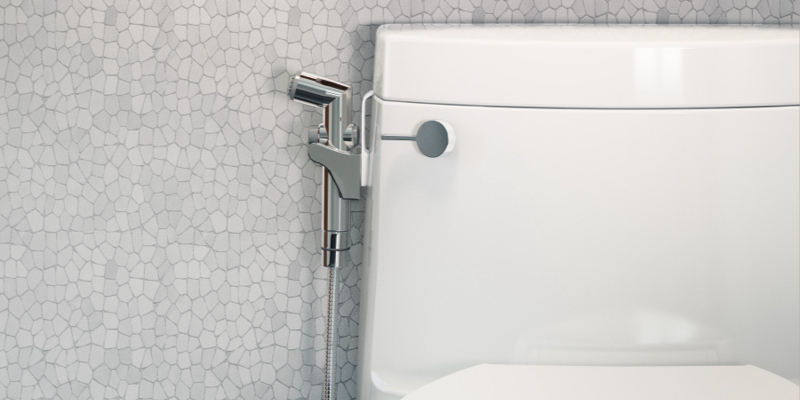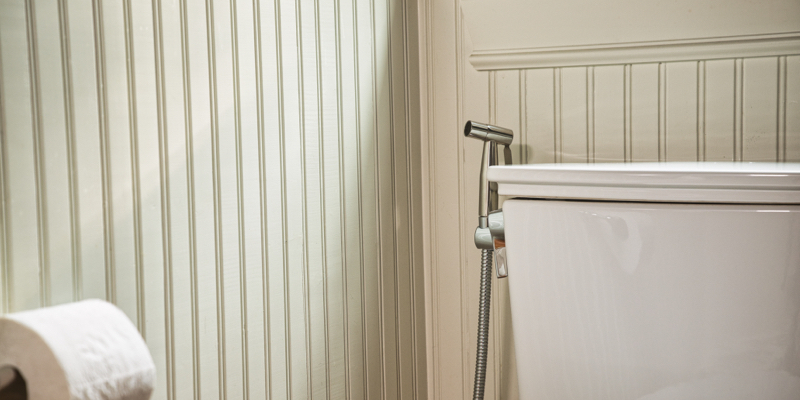
Product in photo: Cleanspa Luxury Handheld Bidet
Bidets come in all shapes and sizes, and many of them are loaded with luxury features to help boost hygiene and comfort in the bathroom. But what if you’re looking for something more basic that doesn’t use electricity? In that case, a handheld bidet may be for you.
What is a handheld bidet?
Handheld bidets are like standard handshowers, but for toilet washing. They’re made up of only a few parts—a long hose and sprayer head—and they connect to your toilet's clean, incoming water supply so a fresh wash is ready after you go.
Handheld bidets have a few other names, like “toilet sprayers,” “bidet showers,” and “diaper sprayers.” Handheld bidets also carry some significance for certain cultures. For example, cleanliness is a core tenet of Islamic communities. As a result, handheld bidets, or shattafs, are commonly seen next to toilets in predominantly Muslim countries.

How do handheld bidets work?
Handheld bidets work by diverting clean water from your toilet’s main water line using an adapter called a T-Valve. Not big on DIY projects? Don’t worry—T-Valves are very easy to install and come included with your bidet. T-Valves have a small lever on them that, when turned on, allows water to flow through the hose and the sprayer.
All that's left to do is aim and spray, and better hygiene will follow (more on that below).
Compared to other bidets, the manual aiming from handheld bidets allows you to have a more intuitive control of your clean. Another benefit is that they don’t need electricity, which is ideal for bathrooms without electrical outlets.
One thing to keep in mind is that most bidet sprayer setups can’t provide warm water washes. If temperature control is a must for you, consider getting a bidet attachment with a warm water line or an electronic bidet toilet seat.
Using a handheld bidet sprayer.
Using a handheld bidet is simple, with a little practice. Let's break it down so you can get the best wash possible.
Step 1: Turn on the T-Valve.
If you’ve ever used a garden hose with a sprayer, you’ll know that you have to turn on the spigot for water to fill the whole setup so you can start spraying.
A handheld bidet operates in the same way, except instead of a spigot, you have your T-Valve.
When you're ready to wash, reach behind your toilet and turn the T-Valve on. Don't worry about shooting water everywhere—the bidet won't spray until you push the trigger or switch on the sprayer.
Step 2: Aim and wash.
While sitting on the toilet, lower the bidet sprayer into the bowl and aim at the area you want to wash.
How you wash depends on the type of sprayer you have. If you have one with a pressure control trigger, you can adjust the flow by pressing down or letting up on the trigger. Some bidets, however, just turn on and off with a button or switch.
If the water pressure is still too low or high, you can use the lever on the T-Valve to adjust. Just be careful not to increase it too much as that can cause discomfort. Adjusting the water pressure with the T-Valve isn't difficult, but if you want to dial it in more precisely, a bidet attachment might be more up your alley.
Once you feel clean, turn off your sprayer to stop the water flow.
You should be quite clean from the bidet, but you may be a little damp down under. Dry off by gently wiping with a square or two of toilet paper—or go with a clean, dry bidet towel for an even more sustainable option.
Pro tip: There are ergonomically designed bidet sprayers if you have hand pain, mobility issues, or just find it hard to aim with a regular handheld bidet.

Product in photo: Cleanspa Luxury Hand-held Bidet, Polished Chrome
Step 3: Turn off the T-Valve.
Before moving on with your day, there’s one last step that’s really important when it comes to handheld bidets specifically.
When you're done washing, always turn off the T-Valve.
If this isn’t done, water will be continually diverted to the sprayer, putting pressure on its components. This can cause unnecessary wear and tear on your bidet that can lead to damage—or worse, leaking and even flooding.
Fortunately, this is easy to avoid. Just turn off the T-Valve when the bidet isn’t in use.
No nonsense, just clean.
Handheld bidet sprayers are a great way to get a bidet wash wash without all the bells and whistles of a bidet toilet seat or attachment. They’re affordable, easy to install with a few basic tools, and will last a long time with proper care and use. Handheld bidets also feel less intimidating and more familiar than other designs. That leads to feeling comfortable—which is how we want you to feel about switching to a bidet.
